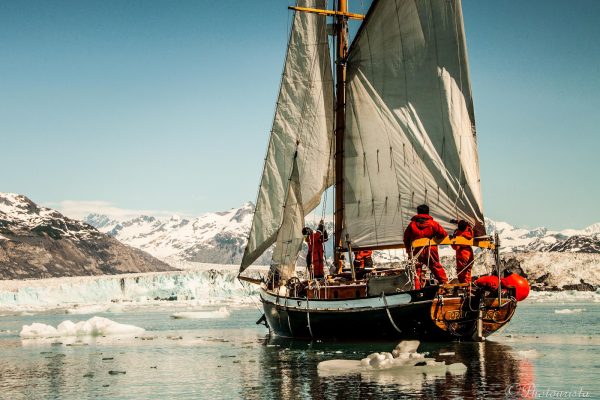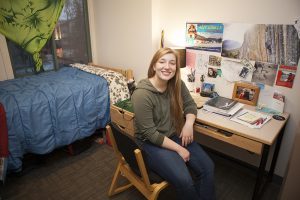‘I’m concerned with making sure our voices are heard’
by Tracy Kalytiak |

Jannelle Trowbridge and her family sailed the Northwest Passage on this 30-foot sailboat, "Precipice", back in 2009. They stopped in Nome to repair an engine problem-and ended up setting down roots. Here, Precipice sails in Prince William Sound. (Photo by Rachael Scholten)
Jannelle Trowbridge once was a Michigan girl, a 10-year-old with a younger sister and the kind of parents who rode motorcycles on their honeymoon and loved to sail.

UAA sophomore Jannelle Trowbridge is a UAA biological sciences major who serves as an Arctic Youth Ambassador. (Photo by Philip Hall / University of Alaska Anchorage)
That was before June 14, 2008, when Jannelle and her family launched a voyage that brought them through the Great Lakes and 2,340-mile St. Lawrence Seaway, paused for the winter in Newfoundland and then threaded through the Northwest Passage.
"Ever since I was born, they'd been planning a sailing adventure," said Jannelle, a UAA sophomore, two-time Jr. Iditarod musher, and Arctic Youth Ambassador. "We started with a little 26-foot fiberglass boat crossing Lake Michigan every weekend and eventually got the boat we have now-a 27-foot Bristol channel cutter. It's a wooden boat, 10 tons ... like a solid, ocean-worthy boat."
The family decided to sail their boat, Precipice, from Greenland to Dutch Harbor, Vancouver and then on to Seattle. An approximately 3-inch-long twist of metal, however, determined they would stop-and then remain, possibly permanently--in Nome.
Finding innovative solutions
That twist of metal was a valve spring for an 18-horsepower 1978 Sabb 2h diesel engine. Her father had brought along extras, but they failed, one by one, along the way.
Losing valve springs wasn't the only hazard they faced.
"There was one point where we followed one of the smaller channels going down, and the ice closed around us," she said. "We had to back the boat up and ram it up on the ice and [the ice] would break down. It was dramatic in a way because the bottom paint that's toxic to algae-so it doesn't grow on it-is kind of soft, so this red paint was rubbing off on the ice so it looked like the boat was bleeding."
Each lead they followed reached a dead end. They almost gave up hope of finding their way through the Passage, until Jannelle's mother spotted another "lead" offering a way for them to follow and continue their trip.
"The Northwest Passage is almost like being on the moon," Jannelle said. "What my dad always says is, 'The beauty of the Passage is what's not there.' The water's super calm; sunrises are really pretty. On the Northwest Passage, there aren't many stopping points and you don't really want to dilly-dally because you're legitimately in water that will freeze if you stay too long."
The family finally emerged from the Passage. Storms buffeted the craft. Over and over, valve springs broke, disabling the engine.
"Imagine when your transmission grinds and then abruptly catches a gear, metal hitting metal," Jannelle said of the sound. "There's no longer a comforting rhythm. It's an abrupt change that compels action."
Her father improvised, crafting new valve springs out of pieces of the old ones. Four miles out of Nome, a valve fell into the cylinder of the engine. Her father called Nome.
"We ended up trading our bear gun for a tow into Nome," Jannelle said. "Within a week, my sister and I were in the Nome school and my mom and dad had found jobs and an apartment."
Creating Arctic awareness
The family acclimated quickly. They pitched in to repair their boat's sail, snowmachined into the mountains, watched mushers finishing the Iditarod, sailed to Providenya, Russia. Jannelle excelled in school, took a class on Alaska Native needlework (making a pair of sealskin baby shoes), completed a junior lifeguard class and learned CPR and rescue skills. She ran and skied on Nome-Beltz's Junior/Senior High School's cross country teams. The family began mushing, and Jannelle took part in two Jr. Iditarod races.
"We now have 42 dogs," she said.
A counselor advised her to apply for ANSEP. Scholarships from ANSEP, Norton Sound Health Corp. and Norton Sound Economic Corp. brought her to UAA in 2015.
"Moving to Anchorage shocked me more than coming to Nome, eating muktuk and learning to mush, because I had to leave my family," she said. "Coming from a dusty small town to a big city where shoes never touch dirt."
Now, she is majoring in biological sciences-delving into research on the effects of plastics birds ingest and whether those effects are passed into eggs eaten by people who live a subsistence lifestyle. Jannelle is also studying otoliths.
"Those are earbones of fish," she explained. "They have growth rings; you can put cross sections under a microscope to look for rings and see how old the fish is."
Jannelle is also involved in EXITO research examining healthcare disparities in rural Alaska and serves as an Arctic Youth Ambassador, working to raise awareness of what it is like to be a youth living in the U.S. Arctic.
"The U.S. is an Arctic nation, but only a small percentage of [Americans] live in Alaska, so the rest of the people who influence our politics aren't aware of our identity," she said. "When they find out a T-bone steak costs $106 in Togiak, they ask, 'Why not move?' People are more transient in the Lower 48, but [residents of a rural Alaska village] can't just unharness and leave without creating issues in that community's health. I'm concerned with making sure our voices are heard."
Written by Tracy Kalytiak, University of Alaska Anchorage
 "‘I’m concerned with making sure our voices are heard’" is licensed under a Creative Commons Attribution-NonCommercial 4.0 International License.
"‘I’m concerned with making sure our voices are heard’" is licensed under a Creative Commons Attribution-NonCommercial 4.0 International License.














